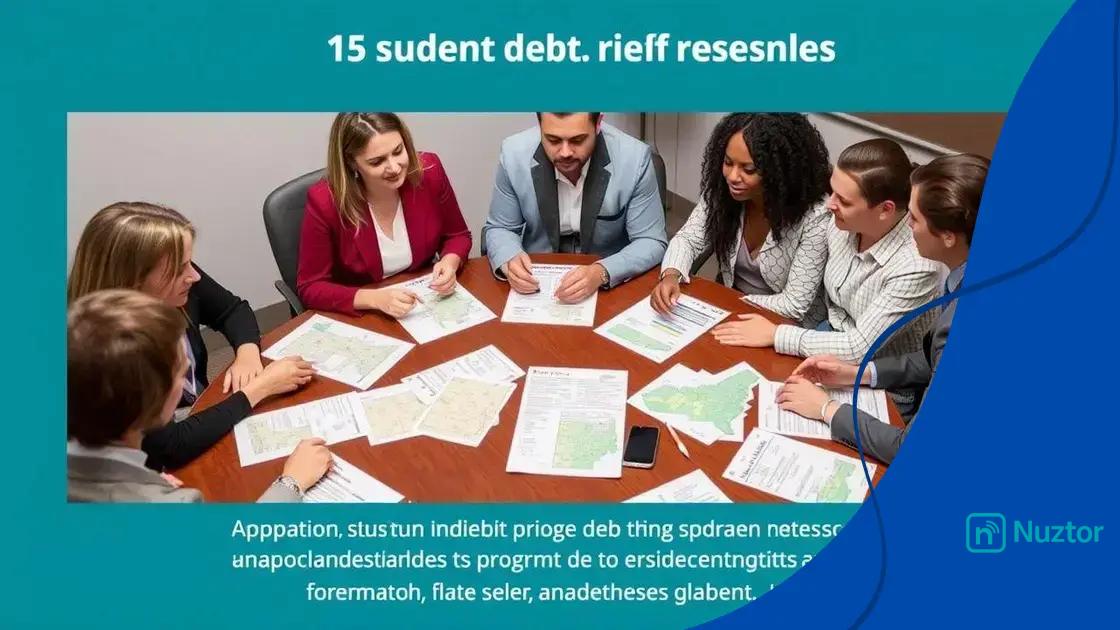Student debt relief options that might surprise you

Student debt relief options include various federal forgiveness programs, state-specific assistance, and alternative repayment plans designed to help borrowers manage their student loans effectively.
Student debt relief options can feel like a maze, especially with so many choices available. Have you ever wondered which options could truly ease your burden? Let’s dive into some insights that might just surprise you.
Understanding student debt relief options
Understanding student debt relief options can seem daunting, yet it’s crucial for managing your financial future. In this section, we will explore the various avenues available to help lessen the burden of student loans.
What Are Student Debt Relief Options?
Student debt relief options comprise several types of programs designed to reduce or eliminate your loan balance. These programs are typically offered through federal and state governments or educational institutions.
Types of federal student loan forgiveness
Federal student loan forgiveness is one of the best-kept secrets in helping students manage their debt. Different programs cater to specific professions or circumstances:
- Public Service Loan Forgiveness (PSLF): Available for those who work in qualifying public service jobs, you can have your remaining loans forgiven after making 120 qualifying payments.
- Teacher Loan Forgiveness: If you teach full-time for five consecutive years in a low-income school, you may qualify for forgiveness on up to $17,500 of your loans.
- Income-Driven Repayment Forgiveness: After 20 or 25 years of qualifying payments under an income-driven repayment plan, the remaining balance may be forgiven.
These options can make all the difference if you are struggling to keep up with monthly payments. Exploring these avenues may provide you with a clearer path to financial freedom.
State-specific relief programs
Many states offer their own student debt relief programs that you may not be aware of. These programs are tailored to meet the needs of residents and support local employment sectors.
Some states, for instance, provide loan repayment assistance programs (LRAPs) for professionals in high-demand areas. If you work in fields like healthcare, teaching, or law enforcement, check if your state has a program that can help lighten your debt load.
Alternative repayment plans and options
In addition to forgiveness programs, there are alternative repayment plans that can make managing your loans easier. These include:
- Extended repayment plans: Allow for a longer repayment period to lower your monthly payments.
- Graduated repayment plans: Payments start lower and increase every two years, which might suit those expecting income growth.
- Revised Pay As You Earn (REPAYE): Your payments are based on your income, and any remaining balance can be forgiven after a certain period.
Reviewing these options regularly can help you stay informed and take advantage of any new programs.
Types of federal student loan forgiveness
There are several types of federal student loan forgiveness programs available, each designed to help borrowers in specific scenarios. Understanding these options can empower you to take charge of your student loan situation.
Public Service Loan Forgiveness (PSLF)
PSLF is targeted at individuals working in the public service sector. If you have made 120 qualifying payments while employed full-time at a qualifying employer, you may have your remaining loan balance forgiven. This is a great option for teachers, nurses, and other public service workers.
Teacher Loan Forgiveness
If you are a teacher who has worked full-time for five complete and consecutive years in a low-income school, you might qualify for Teacher Loan Forgiveness. Depending on your teaching subject and years of service, you could have up to $17,500 of your loans forgiven.
Income-Driven Repayment Forgiveness
If you are enrolled in an income-driven repayment plan, after 20 or 25 years of qualifying payments, any remaining loan balance may be forgiven. This plan adjusts your monthly payment based on your income, making it more manageable during tough financial times.
- Pay As You Earn (PAYE): Caps your monthly payment at 10% of your discretionary income.
- Revised Pay As You Earn (REPAYE): Similar to PAYE but with additional benefits, like forgiveness after 20 years for undergraduate loans.
- Income-Based Repayment (IBR): Your payment is based on your income and can change as your income varies.
These forgiveness options offer significant relief for those who qualify. Knowing which program aligns with your financial and employment situation is essential for taking advantage of what’s available to you.
Federal Family Education Loan (FFEL) Forgiveness
If you have loans under the FFEL program, you might be eligible for forgiveness through certain repayment plans. Additionally, staying updated on policy changes regarding FFEL forgiveness is vital as new initiatives may emerge.
Staying informed and proactively exploring these options can lead to substantial savings. Make sure to do your research and consult with loan servicers to fully understand your eligibility for these forgiveness opportunities.
State-specific relief programs

State-specific relief programs are important resources that can help borrowers manage their student debt. These programs vary by state and can offer various forms of assistance, often targeting specific professions or requirements.
Understanding State-specific Programs
Many states have established student debt relief programs to support residents struggling with loan payments. These programs aim to attract and retain professionals in high-need fields such as healthcare, education, and public service.
Types of State Programs
Each state may offer unique options tailored to its population. These might include:
- Loan Repayment Assistance: Some states provide financial assistance to help repay loans for graduates working in priority sectors.
- Forgiveness Programs: Certain requirements must be met, such as working in underserved areas, to have portions of your loans forgiven.
- Tax Credits: Some states offer tax credits for graduates who work in specific fields or underserved communities.
Keeping track of these programs can help you make informed decisions about your financial future. It’s beneficial to regularly check with your state’s higher education agency for updates and new offerings.
How to Apply for State Programs
Applying for state-specific relief programs usually involves filling out an application detailing your educational background, profession, and sometimes your financial situation. Be prepared to provide documentation that supports your application.
It’s also important to note that some states require applicants to maintain employment in specific positions for a certain duration as a condition of receiving benefits. Staying in touch with program coordinators can help clarify expectations and benefits.
Understanding how state-specific relief programs work can significantly reduce your student debt burden. By actively seeking out these opportunities, you can enhance your financial well-being and focus on your career.
Alternative repayment plans and options
Alternative repayment plans and options are essential for borrowers struggling to manage their student loans. These plans can provide flexibility and make payments more affordable.
Types of Alternative Repayment Plans
When considering alternative repayment options, it’s important to understand what’s available. Here are some common types:
- Extended Repayment Plans: This plan allows you to extend your payment term up to 25 years, resulting in smaller monthly payments.
- Graduated Repayment Plans: Payments start low and gradually increase every two years, which can help when you anticipate future income growth.
- Income-Driven Repayment Plans: These plans adjust your monthly payment based on your income and family size, making it easier to manage payments.
Income-driven plans are particularly beneficial as they can lead to loan forgiveness after a certain period. You may qualify for these plans even if you have a mix of federal and private loans.
Benefits of Alternative Repayment Plans
Using alternative repayment options can provide several advantages:
- Lower Monthly Payments: Options like income-driven plans can significantly reduce what you pay each month.
- Flexibility: Many plans allow changes to your payment schedule if your financial circumstances change.
- Potential for Forgiveness: Some repayment plans include terms where remaining balances can be forgiven after a set number of years.
Choosing the right repayment plan is crucial for maintaining financial stability. It’s recommended to review your options regularly, especially if your job status or income changes.
Staying informed about your repayment options ensures that you pick the best path for your financial situation and can help you transition from being overwhelmed by debt to managing it effectively.
How to apply for student debt relief
Applying for student debt relief can seem overwhelming, but understanding the process helps simplify it. Knowing where to start and what documentation you’ll need makes the application easier.
Gather Required Documentation
Before applying, it’s essential to collect all necessary documents. This often includes:
- Loan Information: Know your loan types, balances, and servicers.
- Income Proof: Gather recent pay stubs or tax returns to verify your financial situation.
- Employment Verification: Some programs may require proof of employment or a letter from your employer.
Being prepared with these documents can help expedite the application process.
Online Application Process
Most federal relief programs allow you to apply online. Go to the official website of the program you are interested in, such as Public Service Loan Forgiveness or Income-Driven Repayment plans. The process typically involves:
- Creating an Account: Sign up on the program’s website to start your application.
- Filling Out the Application: Provide all requested information accurately and thoroughly.
- Submitting Documentation: Upload your gathered documents to support your application.
Be sure to track your application status afterward. Some programs allow you to check online for updates.
Follow-Up and Communication
After submitting your application, it’s important to stay in touch with your loan servicer. If they request additional information or clarification, respond promptly. If your application is approved, you’ll receive information on the next steps, such as your new payment plan or forgiveness eligibility.
Understanding how to navigate the application process for student debt relief is crucial to getting the help you need. With preparation and diligence, you can take control of your financial future and find relief from the stress of student loans.
FAQ – Frequently Asked Questions About Student Debt Relief
What are the common types of federal student loan forgiveness programs?
Common programs include Public Service Loan Forgiveness, Teacher Loan Forgiveness, and Income-Driven Repayment Forgiveness, each catering to specific professions or circumstances.
How do state-specific relief programs work?
State-specific programs provide assistance based on residency and often require borrowers to work in high-demand fields like healthcare or education.
What alternative repayment options are available for student loans?
Options include Extended Repayment Plans, Graduated Repayment Plans, and Income-Driven Repayment Plans, all designed to offer more affordable payment structures.
What do I need to apply for student debt relief?
To apply, gather necessary documentation like loan information, proof of income, and employment verification. Applications are usually submitted online.